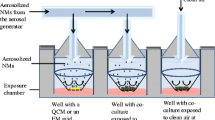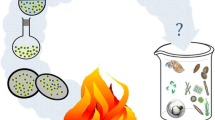Abstract
In experimental toxicology, when simulating human exposure to aerosols in the working environment, inhalation is the route of administration of choice for evaluating the toxicity of a given material (in aerosol form) in animals. In this context, this work aimed to contribute to the establishment of recommendations concerning the characterization of aerosol tests in inhalation toxicology studies. In particular, the work consisted of experimentally characterizing test aerosols using a given generation method to be used for inhalation toxicology studies. Nine nanomaterial powders have been investigated (four types of TiO2, two types of SiO2, ZnO, CeO, and BaSO4). The aerosols produced cover the particle size range from a few tens of nanometers up to several micrometers and are mainly composed of aggregates and/or agglomerates. The work carried out shows that generation and characterization of test aerosols for inhalation toxicology studies is a complex but essential element of inhalation studies, for which the conditions required (stability, repeatability, level of concentration) are sometimes difficult to obtain. Moreover, this study highlights the necessity to carry out preliminary tests to ascertain the performances of the chosen devices and their suitability for inhalation toxicology.

ᅟ





Similar content being viewed by others
References
Adamcakova-Dodd A, Stebounova LV, O’Shaughnessy PT, Kim JS, Grassian VH, Thorne PS (2012) Murine pulmonary responses after sub-chronic exposure to aluminum oxide-based nanowhiskers. Part Fiber Toxicol 9:22. https://doi.org/10.1186/1743-8977-9-22
Asgharian B et al. (2009) Multiple-path particle dosimetry model (MPPD v 2.11): a model for human and rat airway particle dosimetry: Hamner Institutes for Health Sciences Applied Research Associates (ARA), National Institute for Public Health and the Environment (RIVM), and Ministry of Housing, Spatial Planning and the Environment, Editor. Raleigh, North Carolina, USA: Applied Research Associates (ARA)
Asgharian B, Price OT, Oldham M, Chen LC, Saunders EL, Gordon T, Mikheev VB, Minard KR, Teeguarden JG (2014) Computational modeling of nanoscale and microscale particle deposition, retention and dosimetry in the mouse respiratory tract. Inhal Toxicol 26:829–842. https://doi.org/10.3109/08958378.2014.935535
Baker GL, Gupta A, Clark ML, Valenzuela BR, Staska LM, Harbo SJ, Pierce JT, Dill JA (2008) Inhalation toxicity and lung toxicokinetics of C60 fullerene nanoparticles and microparticles. Toxicol Sci 101:122–131. https://doi.org/10.1093/toxsci/kfm243
Bermudez E, Mangum JB, Wong BA, Asgharian B, Hext PM, Warheit DB, Everital JI (2004) Pulmonary responses of mice, rats, and hamsters to subchronic inhalation of ultrafine titanium dioxide particles. Toxicol Sci 77:347–357
Brown JS, Wilson WE, Grant LD (2005) Dosimetric comparisons of particle deposition and retention in rats and humans. Inhal Toxicol 17:355–385. https://doi.org/10.1080/08958370590929475
Buckley A, Hodgson A, Warren J, Guo C, Smith R (2016) Size-dependent deposition of inhaled nanoparticles in the rat respiratory tract using a new nose-only exposure system. Aerosol Sci Technol 50:1–10. https://doi.org/10.1080/02786826.2015.1124987
CEN (2013) TS 16450:2013 Ambient air. Automated measuring systems for the measurement of the concentration of particulate matter (PM10; PM2,5)
Charvet A, Bau S, Paez-Coy NE, Bémer D, Thomas D (2014) Characterizing the effective density and primary particle diameter of airborne nanoparticles produced by spark discharge using mobility and mass measurements (tandem DMA/APM). J Nanopart Res 16:2418
Cosnier F, Bau S, Grossmann S, Nunge H, Brochard C, Viton S, Payet R, Witschger O, Gaté L (2016) Design and characterization of an inhalation system to expose rodents to nanoaerosols. Aerosol Air Qual Res 16:2989–3000. https://doi.org/10.4209/aaqr.2016.01.0034
De Carlo PF, Slowik JG, Wornsop DR, Davidovits P, Jimenez JL (2004) Particle morphology and density characterization by combined mobility and aerodynamic diameter measurements. Part 1: theory. Aerosol Sci Technol 38:1185–1205
Elder A, Gelein R, Finkelstein JN, Driscoll KE, Harkema J, Gn O (2005) Effects of subchronically inhaled carbon black in three species. I. Retention kinetics, lung inflammation, and histopathology. Toxicol Sci 88:614–629. https://doi.org/10.1093/toxsci/kfi327
Ellinger-Ziegelbauer H, Pauluhn J (2009) Pulmonary toxicity of multi-walled carbon nanotubes (Baytubes (R)) relative to alpha-quartz following a single 6 h inhalation exposure of rats and a 3 months post-exposure period. Toxicology 66:16–29
Geiser M, Kreyling WG (2010) Deposition and biokinetics of inhaled nanoparticles. Part Fiber Toxicol 7:2. https://doi.org/10.1186/1743-8977-7-2
ICRP (1994) Publication 66: Human respiratory tract model for radiological protection:Oxford: Pergamon
ISO (2009) 15767. Workplace atmospheres—controlling and characterizing uncertainty in weighing collected aerosols
ISO (2012) TR 13014. Nanotechnologies—Guidance on physico-chemical characterization of engineered nanoscale materials for toxicologic assessment
Jung H, Mulholland GW, Pui DYH, Kim JH (2012) Re-evaluation of the slip correction parameter of certified PSL spheres using a nanometer differential mobility analyzer (NDMA). J Aerosol Sci 51:24–34. https://doi.org/10.1016/j.jaerosci.2012.04.005
Li J-G, Li WX, Xu JY, Cai XQ, Liu RL, Li YJ, Zhao QF, Li QN (2007) Comparative study of pathological lesions induced by multiwalled carbon nanotubes in lungs of mice by intratracheal instillation and inhalation. Environ Toxicol 22:415–421. https://doi.org/10.1002/tox.20270
Ma-Hock L, Treumann S, Strauss V, Brill S, Luizi F, Mertler M, Wiench K, Gamer AO, van Ravenzwaay B, Landsiedel R (2009) Inhalation toxicity of multiwall carbon nanotubes in rats exposed for 3 months. Toxicol Sci 112:468–481. https://doi.org/10.1093/toxsci/kfp146
Ma-Hock L, Strauss V, Treumann S, Küttler K, Wohlleben W, Hofmann T, Gröters S, Wiench K, van Ravenzwaay B, Landsiedel R (2013) Comparative inhalation toxicity of multi-wall carbon nanotubes, graphene, graphite nanoplatelets and low surface carbon black. Part Fiber Toxicol 10:23. https://doi.org/10.1186/1743-8977-10-23
Mercer RR, Scabilloni JF, Hubbs AF, Wang L, Battelli LA, McKinney W, Castranova V, Porter DW (2013) Extrapulmonary transport of MWCNT following inhalation exposure. Part Fiber Toxicol 10:38. https://doi.org/10.1186/1743-8977-10-38
Morimoto Y, Horie M, Kobayashi N, Shinohara N, Shimada M (2012) Inhalation toxicity assessment of carbon-based nanoparticles. Acc Chem Res 46:770–781
Noël A, Cloutier Y, Wilkinson KJ, Dion C, Hallé S, Maghni K, Tardif R, Truchon G (2013) Generating nano-aerosols from TiO2 (5 nm) nanoparticles showing different agglomeration states. Application to toxicological studies. J Occup Environ Hyg 10:86–96
Nurkiewicz TR, Porter DW, Hubbs AF, Cumpston JL, Chen BT, Frazer DG, Castranova V (2008) Nanoparticle inhalation augments particle-dependent systemic microvascular dysfunction. Particle and Fibre. Toxicology 5(1):1. https://doi.org/10.1186/1743-8977-5-1
Oberdörster G, Castranova V, Ashgarian B, Sayre P (2015) Inhalation exposure to carbon nanotubes (CNT) and carbon nanofibers (CNF): methodology and dosimetry. J Toxicol Environ Health B 18:121–212
OECD (2012a) Guidance on sample preparation and dosimetry for the safety testing of manufactured nanomaterials ENV/JM/MONO:40
OECD (2012b) Inhalation toxicity testing: expert meeting on potential revisions to OECD test guidelines and guidance document ENV/JM/MONO:14
OECD (2017) OECD guideline for the testing of chemicals - Test No. 412: Subacute. Inhalation Toxicity: 28-Day Study
Oller AR, Oberdörster G (2016) Incorporation of dosimetry in the derivation of reference concentrations for ambient or workplace air: a conceptual approach. J Aerosol Sci 99:40–45. https://doi.org/10.1016/j.jaerosci.2016.01.015
Pauluhn J (2010) Subchronic 13-week inhalation exposure of rats to multiwalled carbon nanotubes: toxic effects are determined by density of agglomerate structures, not fibrillar structures. Toxicol Sci 113:226–242
Porter DW et al. (2001) Time course of pulmonary response of rats to inhalation of crystalline silica: histological results and biochemical indices of damage, lipidosis, and fibrosis 20:14 doi:10.1615/. J Environ Pathol Toxicol Oncol. v20.iSuppl.1.10
Porter DW, Hubbs AF, Mercer R, Robinson VA, Ramsey D, McLaurin J, Khan A, Battelli L, Brumbaugh K, Teass A, Castranova V (2004) Progression of lung inflammation and damage in rats after cessation of silica inhalation. Toxicol Sci 79:370–380. https://doi.org/10.1093/toxsci/kfh110
Porter DW, Millecchia LL, Willard P, Robinson VA, Ramsey D, McLaurin J, Khan A, Brumbaugh K, Beighley CM, Teass A, Castranova V (2006) Nitric oxide and reactive oxygen species production causes progressive damage in rats after cessation of silica inhalation. Toxicol Sci 90:188–197. https://doi.org/10.1093/toxsci/kfj075
Porter DW et al. (2012) Acute pulmonary dose-responses to inhaled multi-walled carbon nanotubes. In: Nanotoxicology
Tsai C-J, Lin G-Y, Liu C-N, He C-E, Chen C-W (2012) Characteristic of nanoparticles generated from different nano-powders by using different dispersion methods. J Nanopart Res 14:777. https://doi.org/10.1007/s11051-012-0777-9
Virtanen A, Ristimäki J, Keskinen J (2004) Method for measuring effective density and fractal dimension of aerosol agglomerates. Aerosol Sci Technol 38:437–446
Funding
The research leading to these results was partially funded by the European Union Seventh Framework Programme (FP7/2007-2013) under the project NANoREG (A common European approach to the regulatory testing of nano-materials), grant agreement 310584.
Author information
Authors and Affiliations
Corresponding author
Ethics declarations
Conflict of interest
The authors declare that they have no conflict of interest.
Rights and permissions
About this article
Cite this article
Bau, S., Bourrous, S., Gaie-Levrel, F. et al. Characterization of aerosols generated from nine nanomaterial powders: reliability with regard to in vivo inhalation toxicology studies. J Nanopart Res 20, 276 (2018). https://doi.org/10.1007/s11051-018-4381-5
Received:
Accepted:
Published:
DOI: https://doi.org/10.1007/s11051-018-4381-5




